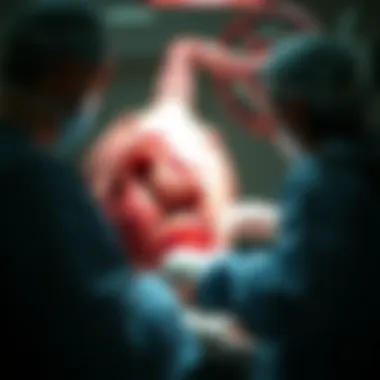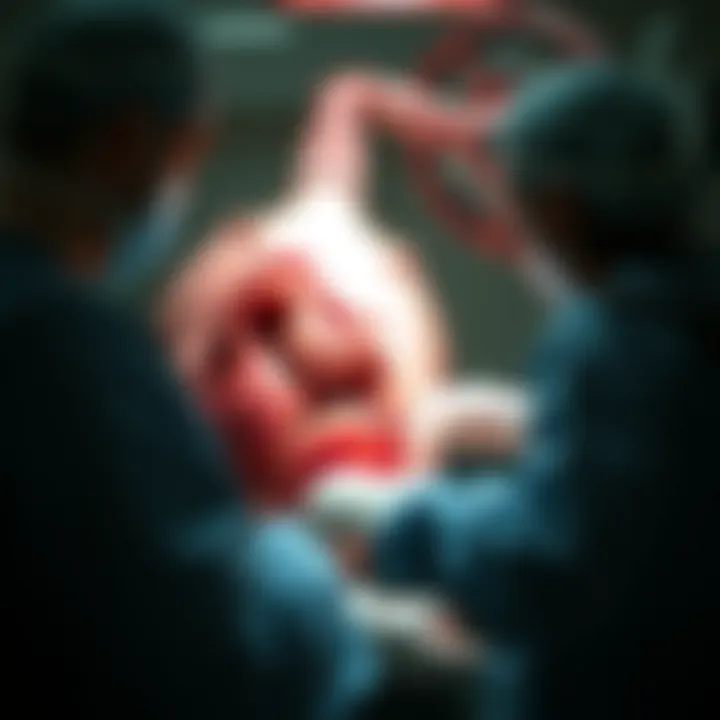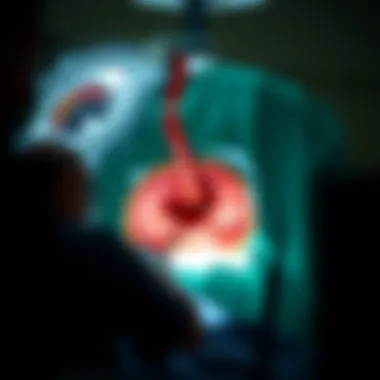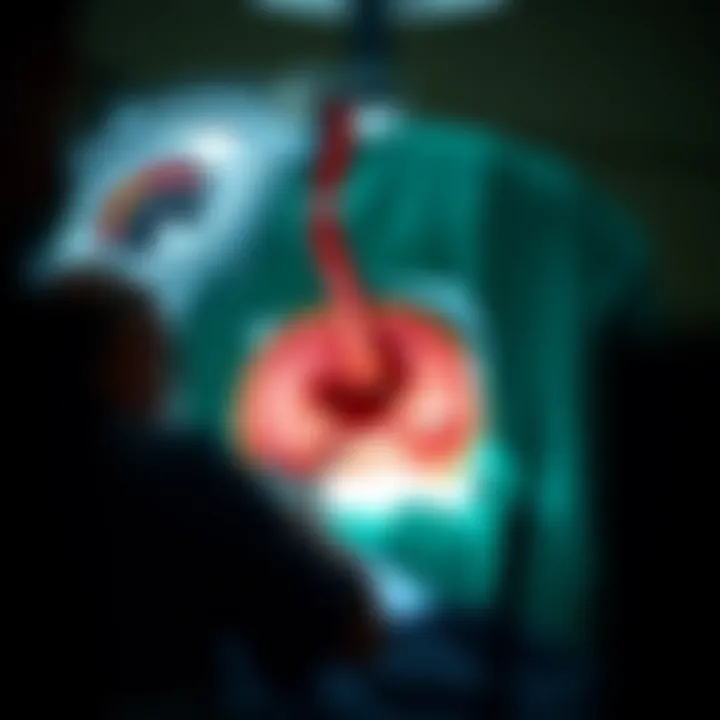In-Depth Analysis of Hiatus Hernia Repair Surgery


Intro
Hiatus hernia repair surgery isn’t just a procedure; it’s a tailored solution that addresses a challenging medical condition. Let’s unpack what hiatus hernias are, how they come about, and why surgical intervention becomes necessary in certain cases. This article serves as a deep dive into the topic, aimed at equipping students, researchers, and healthcare professionals with the knowledge required to understand both the surgical techniques and the patient pathways involved.
Key Concepts and Terminology
Definition of Key Terms
Before delving further, it’s crucial to clarify some terms. A hiatus hernia occurs when part of the stomach pushes through the diaphragm into the chest cavity. The diaphragm is that muscle that separates the chest from the abdomen and plays a vital role in breathing. Understanding this relationship is key to grasping why hernias occur and how they can impact one's health.
Concepts Explored in the Article
Many concepts will surface throughout this discussion, such as:
- Types of Hiatus Hernias: Primarily, they are categorized as sliding and paraesophageal hernias.
- Symptoms: Symptoms can vary and may include heartburn, chest pain, and difficulty swallowing.
- Surgical Techniques: This includes fundoplication and other methods to repair the hernia.
Findings and Discussion
Main Findings
Current research indicates that the approach to hiatus hernia repair greatly influences patient outcomes. A significant observation is that minimally invasive surgeries tend to promote quicker recovery times and fewer complications. Also worth noting is the correlation between obesity and an increased risk of hiatus hernias, emphasizing the need for lifestyle modifications in prevention strategies.
Potential Areas for Future Research
As the field continues to evolve, several areas for further study emerge:
- Long-term outcomes of different surgical methods and techniques.
- The connection between lifestyle factors and hiatal hernia prevalence.
- Advances in materials for surgical meshes that can reduce recurrence rates.
It’s essential for healthcare providers to stay informed about the latest research in hiatus hernia repair to offer the very best care.
By laying a foundation of understanding the key concepts and findings surrounding hiatus hernia repair surgery, we prepare to explore further the surgical approaches, postoperative care, and the potential complications faced by patients. While it may seem a technical topic, the implications of such surgeries deeply echo in the lives of individuals navigating these health challenges.
Preface to Hiatus Hernia
Understanding hiatus hernias is essential for grasping the broader context of surgical management within gastroenterology. These hernias can significantly impact a patient’s quality of life, as they lead to ailments like acid reflux and dysphagia. In fact, recognizing the signs and symptoms early can facilitate timely interventions, reducing complications down the road. Moreover, educating patients and healthcare professionals on this topic may foster a more informed dialogue, ultimately shaping better therapeutic strategies.
Definition of Hiatus Hernia
A hiatus hernia occurs when a part of the stomach bulges through the diaphragm's opening into the chest cavity. The diaphragm is a muscular barrier that typically helps keep the stomach in place. When it weakens, it allows this abnormal protrusion, which can cause discomfort and a variety of symptoms.
Types of Hiatus Hernia
There are three main types of hiatus hernias, each differing significantly in their anatomy and implications for surgical treatment.
Sliding Hiatus Hernia
A sliding hiatus hernia is the most common type, where the gastroesophageal junction and a portion of the stomach slide up into the thoracic cavity. This type is particularly noteworthy because it can often present with minimal symptoms, making it easily overlooked. That said, its propensity to lead to gastroesophageal reflux disease (GERD) has earned it significant attention in clinical settings.
A key characteristic of this type is its dynamic nature. The hernia may be present during certain activities or positions, making it tricky for doctors to diagnose. The benefits of recognizing this condition lie in its association with many lifestyle modifications and nonsurgical interventions that can enhance a patient’s well-being without necessitating extensive surgical procedures.
Paraesophageal Hiatus Hernia
In contrast, a paraesophageal hiatus hernia is less common but can present more serious risks. In this case, part of the stomach pushes next to the esophagus, without displacing the gastroesophageal junction. This abnormality can lead to strangulation or incarceration of the stomach, which may require urgent surgical management.
The most notable characteristic of a paraesophageal hernia is its relatively stable position compared to sliding hernias. Patients often report more severe symptoms, raising the likelihood of their seeking medical assistance. However, surgically addressing this type could offer long-term solutions to patients, increasing the efficiency of their digestive systems and reducing episodes of pain or discomfort.
Mixed Hiatus Hernia
As the name suggests, a mixed hiatus hernia combines features of both sliding and paraesophageal types. This hernia can create a complex clinical picture, often leading to a mix of symptoms associated with both conditions. Characteristically, it can cause notable difficulty in swallowing and chronic heartburn, complicating the diagnosis further.
The mixed hernia often poses a greater challenge for surgical repair due to its multifaceted nature. However, recognizing it enhances the comprehensive understanding of hiatus hernia pathologies and their potential interventions. The advantages here lie in the awareness it brings—helping patients and healthcare providers navigate the intricacies of surgical options more effectively.
Understanding Symptoms
In the context of hiatus hernia repair surgery, understanding the symptoms associated with this condition is vital. It's not just about identifying discomfort; these symptoms greatly influence the decision to seek medical help, the timing of surgical intervention, and the patient's overall quality of life. Recognizing symptoms allows both patients and healthcare providers to develop a strategic approach to managing the condition and taking timely action, which can prevent complications down the line.
Common Symptoms


Heartburn and Acid Reflux
Heartburn and acid reflux are perhaps the most recognizable symptoms linked to hiatus hernia. Characterized by a burning sensation in the chest and regurgitation of sour content, this symptom often leads patients to seek assistance. Understanding that these sensations can become frequent and debilitating is essential. Many individuals mistakenly attribute them to diet or lifestyle choices alone, overlooking the underlying issue: the hernia itself.
The key characteristic of heartburn is its persistence. It's not simply an occasional annoyance but often a regular visitor in the lives of those affected. This aspect makes it a focal point for discussions surrounding hiatus hernia because it combines discomfort with potential lifestyle implications. The unique feature of heartburn in this context is its ability to mask more severe conditions, thus misleading patients and delaying diagnosis. Recognizing this symptom can lead to timely intervention, which is paramount in preventing further complications.
Dysphagia
Dysphagia, or difficulty swallowing, brings another layer of complexity to the symptomatology of hiatus hernia. This condition often arises when the esophagus is compressed or obstructed, either by the hernia itself or by associated reflux issues. As problematic as it sounds, dysphagia contributes significantly to the overall narrative surrounding hiatus hernia repair surgery.
The distinctive aspect of dysphagia is the frustration it causes; not being able to swallow can lead to anxiety over eating and drinking, impacting one's nutritional intake. This symptom is a beneficial focus in the article because it highlights the human experience behind the medical condition. Patients may hesitate to communicate this symptom due to embarrassment, yet it's crucial; addressing it can lead to better surgical outcomes.
Chest Pain
Chest pain is often considered a classic symptom yet remains misunderstood. Not all chest pain originates from a heart condition, even though many people fear that it does. In the context of hiatus hernia, it can relate to irritation of the esophagus or pressure from adjacent structures, leading to oft-misdiagnosed symptoms.
The prominence of chest pain in patients, especially older adults, adds a layer of urgency to discussions surrounding surgical intervention. Its unique feature lies in its variabilities: sharp, dull, sporadic, or constant, which can complicate the diagnostic process. The article's emphasis on chest pain is significant for two main reasons: first, it underscores the need for thorough evaluation in the context of hernia repair; second, understanding this symptom can aid in preoperative planning while minimizing unnecessary anxiety.
When to Seek Medical Attention
Understanding when to seek medical attention is crucial for patients experiencing symptoms of a hiatus hernia. It's essential to recognize that not all discomfort indicates the need for immediate intervention, yet certain warning signs are significant. Persistent heartburn affecting daily life, sudden onset dysphagia, and chest pain, particularly when accompanied by other symptoms like sweating or shortness of breath, require prompt medical evaluation. Failing to address these signs can lead to complications that could have been avoided with timely surgical intervention.
Seeking help early can lead to better outcomes and prevent complications. Don't hesitate to talk to your doctor if you're experiencing alarming symptoms.
Diagnostic Approaches
The importance of diagnosing a hiatus hernia cannot be overstated. Understanding exactly what is going on inside a patient's body is key to providing effective treatment. Diagnostic approaches help in determining the type and severity of the hernia, which can guide surgical planning and intervention. Accurate diagnosis can make the difference between a patient's quick recovery and the persistence of troubling symptoms.
Physical Examination
During a physical examination, the healthcare professional typically assesses the patient's medical history and performs a clinical evaluation. They might notice symptoms such as tenderness in the abdomen or changes in the patient's swallowing ability. This examination often serves as a valuable first step toward more advanced diagnostic methods.
Factors including diet, lifestyle, and family history can provide insights into the likely causes of the hiatus hernia. This approach helps in tailoring a more personalized treatment plan. Furthermore, the physical examination might reveal other conditions that co-exist with the hernia, thereby informing comprehensive care strategies.
Imaging Techniques
X-rays
X-rays are commonly utilized in the initial evaluation for hiatus hernia. This imaging technique allows doctors to visualize the position of the stomach and esophagus. One of the key characteristics of X-rays is their availability and speed; they can be performed in most urgent care settings.
X-rays can spot larger abnormalities, including obvious hernias. However, a significant disadvantage is that they often miss smaller or less severe cases. Unlike other imaging modalities, X-rays might not provide sufficient detail on the surrounding tissues, which can limit diagnosis.
Endoscopy
Endoscopy takes a closer look inside the esophagus and stomach by using a flexible tube with a camera. This technique becomes particularly advantageous when doctors suspect complications from a hiatus hernia, such as inflammation or ulcers. A distinct feature of endoscopy is its ability to provide direct visualization, enabling biopsy if required.
Though beneficial, it does come with risks such as bleeding or infection. Patients may also experience some discomfort during the procedure, which lengthens recovery time. These factors must be considered while opting for an endoscopy.
CT Scan
A CT scan offers detailed cross-sectional images of the abdomen and is extremely useful for diagnosing hiatus hernias. One of the significant advantages of CT scans is their ability to visualize not just the hernia but also the surrounding anatomical structures. This characteristic makes them a critical tool in surgical planning, providing essential information on the condition and position of the organ involved.
However, the downside lies in the exposure to radiation and potential contrast allergies, which not every patient can tolerate. CT scans also tend to be more expensive than other imaging methods, which can be a consideration in some healthcare settings.
Additional Diagnostic Tests
Esophageal Manometry
Esophageal manometry measures the rhythmic muscle contractions in the esophagus when swallowing. This test helps to evaluate how well the esophagus is functioning and can discern how a hiatus hernia may be affecting swallowing. It is particularly valuable when dealing with patients who experience significant dysphagia, as it identifies motility issues.
A notable upside of esophageal manometry is its non-invasive nature, making it more comfortable for patients. However, it does require specialized equipment and trained personnel, which may not be available in all clinics.
24-Hour pH Monitoring
The 24-hour pH monitoring test tracks acid reflux over a full day. It helps determine how much acid enters the esophagus, which is invaluable in diagnosing gastroesophageal reflux disease often associated with hiatus hernias. The unique feature of this test is its duration, capturing a comprehensive picture of a patient's acid exposure levels throughout their daily activities.
While this test is particularly effective in assessing reflux severity, patients may find wearing the pH monitor inconvenient, as it involves a small sensor in the esophagus. Some might even experience discomfort during the test, which can impact patient compliance and the quality of collected data.


Through these diagnostic approaches, healthcare providers can build a clearer picture of a patient's hiatus hernia, which is fundamental to establishing an appropriate treatment protocol.
The array of diagnostic techniques—from physical exams to sophisticated imaging methods—ensures that clinicians can offer a precise diagnosis and cater to individual patient needs. Adequate diagnostic work-up is crucial in optimizing treatment strategies and improving patient outcomes.
Surgical Techniques and Approaches
Surgical techniques and approaches play a crucial role in the management of hiatus hernias. The selection of a technique can significantly impact recovery time, the degree of post-surgical discomfort, and the long-term success of the surgery. The choice also hinges on factors such as the type of hernia, patient health, and technological advancements in surgical methods. Understanding these techniques helps patients and practitioners gauge what to expect during and after surgery.
Laparoscopic Hiatus Hernia Repair
Laparoscopic hiatus hernia repair has emerged as a favored choice among surgeons and patients alike, primarily due to its minimally invasive nature. In this procedure, several small incisions are made in the abdominal wall, allowing the surgeon to insert a camera and special instruments to conduct the repair. The benefits of this approach are plenty: reduced post-operative pain, shorter hospital stays, and quicker recovery times are among the most significant advantages.
Patients often find they can return to their normal activities within days rather than weeks, which makes it an appealing option. However, this method requires a surgeon skilled in laparoscopic techniques, which can vary in availability. The careful selection of this approach has proven to enhance patient outcomes and satisfaction.
Open Surgery Techniques
Open surgery, although less commonly used today, is another approach for repairing hiatus hernias, especially in complex cases or those that cannot be addressed laparoscopically. This technique involves a larger incision in the abdomen, allowing the surgeon direct access to the esophagus and diaphragm. While open surgery can be associated with longer recovery times and increased post-operative pain, it also allows for a more thorough exploration of the area, making it suitable for certain individuals.
Surgeons might opt for this technique when there is a high likelihood of complications or when significant scarring from previous surgeries complicates a laparoscopic approach. Moreover, patients with larger paraesophageal hernias often benefit more from open surgery, where the reconstruction of the esophageal hiatus can be more effectively managed.
Innovative Surgical Methods
Robotic Surgery
Robotic surgery is a modern advancement that leverages sophisticated robotic systems to assist surgeons during the repair of hiatus hernias. The key characteristic of robotic surgery is its enhanced precision, which is particularly beneficial in delicate procedures like hernia repair. Surgeons operate the robotic system from a console, which provides a 3D view of the surgical field and allows for better maneuverability compared to traditional or laparoscopic techniques.
The biggest draw of robotic surgery is its potential for greater accuracy, leading to fewer complications and quicker healing times. However, access to robotic surgery can be limited, and not all surgeons are trained in this advanced method. Additionally, the cost of robotic-assisted surgeries can be a concern for patients and hospitals alike, often raising questions about whether the benefits outweigh the costs.
Transoral Surgery
Transoral surgery represents another innovative lane in the world of hiatus hernia repair, allowing surgeons to approach the hernia from the mouth rather than through an abdominal incision. This method has gained traction due to its minimally invasive nature, leading to reduced pain and faster recovery. With specialized instruments designed for this technique, surgeons can effectively reposition the hiatal structure and suture it into place without compromising surrounding tissues.
A unique feature of transoral surgery is that it largely eliminates the necessity for external incisions, thus reducing the risk of surgical infection. On the flip side, this approach is still relatively new, and some surgeons may not have extensive experience, which can influence the outcomes. Ultimately, while the method shows promise, discussing the specific risks and benefits with an experienced surgeon is essential for patients considering this route.
The choice of surgical technique can significantly impact recovery time, post-operative pain, and long-term outcomes for hiatus hernia surgeries.
In summary, the evolution of surgical techniques for hiatus hernia repair—from laparoscopic approaches to innovative robotic and transoral options—underscores the importance of selecting a method tailored to each patient's unique condition. It is essential for both practitioners and patients to stay informed about these techniques to ensure optimal outcomes.
Postoperative Care and Recovery
Postoperative care and recovery play a crucial role in ensuring optimal outcomes following hiatus hernia repair surgery. This phase isn’t just about mending the physical aspects; it encompasses a holistic approach to patient health that can affect long-term success. By focusing on targeted recovery strategies, healthcare providers can minimize complications and enhance patient satisfaction.
Immediate Postoperative Care
Right after the surgery, the immediate postoperative phase is paramount. Patients typically spend a short time in a recovery room, monitored closely by medical staff. This monitoring ensures that any immediate complications, such as issues with anesthesia or bleeding, are promptly addressed.
During this phase, several important aspects come into play:
- Pain Management: Managing discomfort is vital in helping a patient transition smoothly. Medications may be administered intravenously or orally depending on the patient's condition and pain levels. The key here is to strike a balance; while pain should be managed effectively, over-medication can introduce its own complications.
- Nutritional Support: Generally, patients might start on a liquid diet post-surgery. This gradual introduction of solid foods is important to avoid undue stress on the esophagus and stomach. Healthcare providers often recommend specific food types and portions to facilitate recovery, guiding patients on what to avoid, especially those that might provoke reflux or irritation.
- Mobility and Activity: Early ambulation is encouraged to improve circulation and decrease the risk of blood clots. Patients may be advised to begin light walking within the first day, progressing slowly as tolerated. However, heavy lifting and strenuous activities should be avoided for several weeks.
"Effective immediate care is like laying a solid foundation for a stable house. If done right, everything built upon it stands the test of time!"
Long-Term Recovery and Follow-Up
Once the immediate care has run its course, long-term recovery becomes the focus. This phase can take several weeks to months, depending on individual health conditions and how well the body responds to surgery. Several key considerations help shape this recovery period:
- Follow-Up Appointments: Regularly scheduled follow-ups with the surgeon or a healthcare provider are essential. These consultations allow for monitoring of healing and any potential complications or recurrent symptoms. During these visits, the effectiveness of lifestyle modifications can also be assessed.
- Lifestyle Modifications: For many patients, adopting changes in diet and eating habits can be crucial. Many healthcare professionals emphasize the importance of smaller, more frequent meals and avoiding trigger foods that might lead to acid reflux or discomfort.
- Physical Rehabilitation: In some cases, engaging in a structured physical rehabilitation program might be suggested. This approach can help patients regain strength and endurance, particularly if they lead a more sedentary lifestyle before surgery.
- Monitoring Mental Well-Being: Recovery is not solely physical. Psychological factors should not be overlooked. Many patients might experience anxiety or depression due to lifestyle changes or ongoing discomfort. Support groups or counseling may be beneficial in these scenarios.
Potential Risks and Complications
Understanding the potential risks and complications associated with hiatus hernia repair surgery is paramount. These elements contribute significantly to the overall effectiveness and safety of the procedure. For many patients, facing surgery can be a daunting prospect, mainly due to concerns about what may go wrong. Thus, delving into these risks helps in setting realistic expectations and enables informed decision-making.
Complications can vary widely among individuals, influenced by factors like general health, surgical technique, and even the surgeon’s experience. This section focuses on surgical complications, which can substantially affect both the short-term recovery and long-term outcomes post-surgery.
Surgical Complications
Infection


Infection is one of the most common risks following any surgical procedure, and hiatus hernia repair is no exception. The body's response to the surgical incision can occasionally lead to infection at the site, which can hinder recovery. Its significance lies in its impact on patient well-being, affecting not only physical health but also mental preparedness for recovery.
One prominent characteristic of infection is that it often surfaces days or even weeks post-surgery, catching patients and doctors off guard. Early identification is crucial, as untreated infections can escalate into more severe health issues.
The complexity of managing infections leads to an array of treatments, including antibiotics and, in some cases, further surgical intervention. While infections are not exclusive to hiatus hernia repairs, they remain a vital consideration for ensuring safe healing.
Bleeding
Another considerable risk linked to surgery is bleeding, which can occur during or after the procedure. While some bleeding is a normal part of surgical processes, significant blood loss can complicate recovery. This risk underscores the importance of surgical skill and precision.
Bleeding can manifest in various ways: externally, as visible blood at the site; or internally, leading to hematomas, which may require additional treatment. The distinctive aspect of bleeding is its potential to necessitate blood transfusions, increasing the complexity of the postoperative experience.
While surgeons take extensive measures to mitigate bleeding during surgery, any blood loss can still destabilize a patient’s recovery. Hence, monitoring frequently becomes crucial in the postoperative period.
Recurrence of Hernia
Recurrence of hernia is a particular concern for many who have undergone hiatus hernia surgery. This occurs when the hernia reappears after the surgical site was believed to be repaired. This aspect is particularly stressful for patients as it questions the efficacy of the original surgery and the investment of time and resources put into recovery.
The key characteristic of recurrence is that it can stem from several factors, including inadequate surgical technique or lifestyle choices that exert pressure on the repaired area. Lifestyle choices could involve heavy lifting or obesity, which may not only precipitate recurrence but raise other health concerns as well.
The unique feature of recurrence lies in the challenge it presents for future repairs, often requiring more complex surgical strategies and longer recovery times than the initial surgery. Hence, successful hiatus hernia repair not only focuses on the immediate results but also on providing long-lasting solutions to the underlying problems.
Long-Term Perspectives
In evaluating the long-term perspectives associated with hiatus hernia repair, it becomes evident that proper understanding and management of surgical risks and complications are integral to overall outcomes. A proactive approach, which consists of regular follow-ups and necessary lifestyle adjustments, can promote enhanced recovery.
As advancements in surgical techniques continue, the understanding of risks also evolves. Newer methodologies promise to mitigate some of the complications discussed, and ongoing research offers hope for improved surgical standards. This section sheds light on both the potential hurdles and the ongoing developments in the field.
"A knowledgeable patient is an empowered patient. Knowing the potential hazards of any medical procedure, especially surgery, enables informed decisions that can impact overall health outcomes."
This understanding serves as a safety net, ensuring that patients have more control over their surgical journeys.
Patient Experiences and Outcomes
Understanding the perspectives of patients who have undergone hiatus hernia repair surgery can illuminate the effects of the procedure on their lives. This section looks into quality of life post-surgery and patient satisfaction, two cornerstones that significantly contribute to the overall evaluation of surgical success.
Quality of Life Post-Surgery
The quality of life after hiatus hernia repair signifies much more than just a clinical outcome; it encompasses the holistic well-being of an individual. After the surgery, many patients report notable improvements in a variety of everyday aspects. For instance, symptoms such as heartburn, regurgitation, and dysphagia may significantly decrease, leading to a more comfortable daily experience. This easing of symptoms often translates into better sleep patterns and reduced anxiety around eating, enhancing social interactions.
Post-surgery lifestyle adjustments can also play a pivotal role. Engaging in regular physical activities typically becomes more feasible, thus promoting better health overall. Patients often find themselves rejuvenated, not just physically, but mentally as well, as they regain confidence in their ability to manage their condition effectively.
However, it is essential to note that the recovery experience varies among individuals. Some may still face challenges, such as the fear of hernia recurrence or ongoing symptomatic episodes. Therefore, follow-up assessments remain critical to address these concerns and ensure that patients are navigating their recovery phase satisfactorily.
Patient Satisfaction
Patient satisfaction is a multifaceted subject and is intrinsically linked to surgical outcomes and post-surgical support. Many studies illustrate that a significant portion of patients express high levels of satisfaction once they see marked improvements in their symptoms and lifestyle. This is particularly true for those who have experienced long-standing discomfort prior to the surgery.
Factors influencing patient satisfaction can include:
- Communication with Healthcare Providers: Open communication can make patients feel more involved in their treatment decision-making.
- Quality of Preoperative Information: Clarity about what to expect before, during, and after the procedure helps alleviate anxiety and prepares patients better.
- Support from Family and Friends: A solid support system often correlates with higher satisfaction rates. Patients who feel encouraged by those around them tend to have a smoother recovery experience.
An interesting point to consider is that patient satisfaction is not confined to the absence of physical discomfort. Emotional well-being, perceived quality of care, and even the aesthetic aspect of surgical scars can shape the overall satisfaction. The importance of these perspectives cannot be overstated, as they influence broader healthcare practices aimed at improving patient care outcomes.
"Real improvements in life quality and satisfaction hinge not just on symptom relief, but also on the comprehensive care and support mechanisms surrounding surgical procedures."
Addressing patient experiences forms a vital aspect of understanding hiatus hernia repair surgery's efficacy. As the medical field continues to innovate, placing emphasis on patient outcomes will remain paramount in shaping surgical approaches and healthcare delivery in the future.
Endings and Future Directions
The exploration of hiatus hernia repair surgery has unveiled various layers of complexity, necessitating a thorough understanding for both practitioners and patients. The significance of this topic lies not only in the surgical techniques employed but also in the diverse patient outcomes and the overall quality of life post-surgery. As we conclude this piece, several key elements need emphasis for future considerations.
First off, one must acknowledge the importance of patient education. With a proper understanding of the condition, its symptoms, and the available surgical options, patients can make informed decisions about their health. Empowering patients is crucial, as it directly correlates with satisfaction levels and the effectiveness of postoperative care. Furthermore, comprehensive preoperative assessments can identify at-risk patients, paving the way for tailored treatment plans that address individual needs effectively.
Another noteworthy point is the evolution of surgical techniques. The ongoing advancements in approaches such as minimally invasive and robotic surgeries significantly enhance recovery times and reduce complications. As these methods continue to gain traction, ongoing training and education for surgeons remain vital to ensure optimal results. Incorporating experience with new technologies could lead to substantial improvements in patient outcomes while driving down long-term costs of care.
Long-term monitoring post-surgery also warrants attention. Successful repair of a hiatus hernia doesn’t stop at the operating table; ongoing follow-up should be integrated into standard care to help catch recurrence or complications early. Regular assessments, including possible endoscopic evaluations, can play a pivotal role in maintaining patient well-being over time.
“The quality of care doesn't just end once the operation is done; it's an ongoing journey that requires commitment from both patient and provider.”
Finally, emerging research into genetic predispositions and environmental factors influencing hiatus hernias may open new avenues for preventative strategies. Understanding and addressing these factors could be key to reducing the incidence of hernias and associated surgical needs in the first place.
Overall, the dialogue surrounding hiatus hernia repair surgery is rapidly evolving. Future directions should involve a collaborative effort among researchers, surgeons, and healthcare professionals to optimize surgical approaches, share knowledge, and ultimately improve patient care. As we stand on the brink of new discoveries, continuing to investigate this domain promises to refine not only surgical practices but also enhance the quality of life for countless patients.







